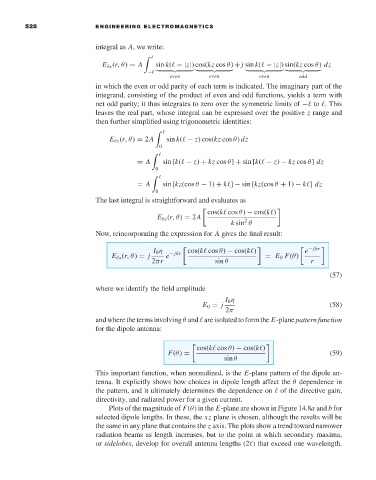Page 546 - Engineering Electromagnetics, 8th Edition
P. 546
528 ENGINEERING ELECTROMAGNETICS
integral as A,we write:
E θs (r,θ) = A sin k( −|z|) cos(kz cos θ) + j sin k( −|z|) sin(kz cos θ) dz
−
even even even odd
in which the even or odd parity of each term is indicated. The imaginary part of the
integrand, consisting of the product of even and odd functions, yields a term with
net odd parity; it thus integrates to zero over the symmetric limits of − to . This
leaves the real part, whose integral can be expressed over the positive z range and
then further simplified using trigonometric identities:
E θs (r,θ) = 2A sin k( − z) cos(kz cos θ) dz
0
= A sin [k( − z) + kz cos θ] + sin [k( − z) − kz cos θ] dz
0
= A sin [kz(cos θ − 1) + k ] − sin [kz(cos θ + 1) − k ] dz
0
The last integral is straightforward and evaluates as
cos(k cos θ) − cos(k )
E θs (r,θ) = 2A
2
k sin θ
Now, reincorporating the expression for A gives the final result:
I 0 η cos(k cos θ) − cos(k ) e − jkr
E θs (r,θ) = j e − jkr = E 0 F(θ)
2πr sin θ r
(57)
where we identify the field amplitude
I 0 η
E 0 = j (58)
2π
and where the terms involving θ and are isolated to form the E-plane pattern function
for the dipole antenna:
cos(k cos θ) − cos(k )
F(θ) = (59)
sin θ
This important function, when normalized, is the E-plane pattern of the dipole an-
tenna. It explicitly shows how choices in dipole length affect the θ dependence in
the pattern, and it ultimately determines the dependence on of the directive gain,
directivity, and radiated power for a given current.
Plots of the magnitude of F(θ)in the E-plane are shown in Figure 14.8a and b for
selected dipole lengths. In these, the xz plane is chosen, although the results will be
the same in any plane that contains the z axis. The plots show a trend toward narrower
radiation beams as length increases, but to the point at which secondary maxima,
or sidelobes,develop for overall antenna lengths (2 ) that exceed one wavelength.

